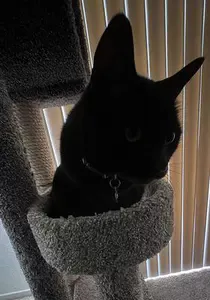My cat is peeing on everything!
by Jennifer Puryear
(TN)
Hi my name is Jennifer and I have a 6 year old male Doll face shaded silver Persian cat named Cash (Cashmere).
He is the only cat in the house and I bought him from a woman who was breeding him with her females. He's a retired show cat/breeder now.
He's not fixed and I don't want to fix him. But here recently I've noticed that he's been peeing (not spraying) on everything! Bathroom rugs, carpets, furniture, shelves.... and I clean his litter box everyday!
I took him to the vet and she said he's absolutely healthy and didn't even show signs of stress. No UTI, blockages, nothing! I don't know how to fix this or what I need to do.
He's been doing this for 2 months and the only change he's had to his routine was 6 months ago when I stayed a week at Vanderbilt hospital and he was left at my mother's, who owns no cats.
He's taken so well care of and I've done everything from changing his litter box location to trying new litter. I don't know what to do and I need help!?
My thoughts:
I'm sorry to hear that your cat is having troubles, Jennifer. This seems like a tricky one since former show cats are usually used to adapting to new environments.
On the other hand, breeder cats and show cats are sometimes kept under very strict conditions. There have been reports of former show/breeder cats having difficulty adapting to the typical life lived by many "regular" house cats.
Or, they're said to have "personality" problems which can surface later. I don't know how long you've had him, but obviously longer than 6 months.
If you've had him for years, then this question may not apply, but if it's less than a year, I'm wondering how his routine is different now from the way it was before you got him?
Is there something he's missing in his life now? Other cats, maybe? That sounds odd, but it could be he's not stimulated enough. Does he need more toys, more interaction, more exercise, more climbing surfaces?
Going beyond that aspect, I don't have any personal experience transitioning a former breeder
With extreme litter box issues, the same approach applies. This has come up many times on this site and I know I sound like a broken record, but isolation retraining is sometimes the only way to get a cat back on track.
Generally, when you don't know what else to try, confine him. Find a sunny room and bring his litter box, toys, bed, blanket, food and water and so on into that room.
Spend time with him and make sure it doesn't feel like punishment. Exercise him and give him attention. Once he's using the box regularly, you can give him more and more access to the rest of the house.
If he has a relapse, the process starts again.
In addition, I would go back to using the litter he always used and place the box where he always used it (assuming isolation works).
I would also add a second box to the house if you haven't already, and move the box from the isolation room back into the house very slowly. Move it a few inches or a foot per day until you get it where you want it.
I would throw in Rescue Remedy or Feliway for good measure, even though the vet said he doesn't seem stressed.
If this is some latent personality issue that goes back to his earlier life, he may need more than just retraining and it may take time.
Finally, what, if anything, changed in his life 2-3 months ago? Or 6 months ago? It could be a delayed reaction to your absence and his stay with your mother, but did something else change?
It could be something relatively simple, so think long and hard. Even new neighbors (or new cats in the neighborhood) could be an issue.
I hope that helps a bit. Please keep us updated on his progress.
-Kurt
P.S. You probably already know this, but do not use ammonia based cleaners in the house. The ammonia smell can trigger urination.

